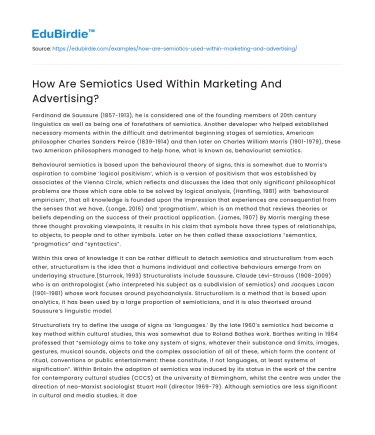Ferdinand de Saussure (1857-1913), he is considered one of the founding members of 20th century linguistics as well as being one of forefathers of semiotics. Another developer who helped established necessary moments within the difficult and detrimental beginning stages of semiotics, American philosopher Charles Sanders Peirce (1839-1914) and then later on Charles William Morris (1901-1979), these two American philosophers managed to help hone, what is known as, behaviourist semiotics.
Behavioural semiotics is based upon the behavioural theory of signs, this is somewhat due to Morris’s aspiration to combine ‘logical positivism’, which is a version of positivism that was established by associates of the Vienna Circle, which reflects and discusses the idea that only significant philosophical problems are those which care able to be solved by logical analysis, (Hanfling, 1981) with ‘behavioural empiricism’, that all knowledge is founded upon the impression that experiences are consequential from the senses that we have, (Longe, 2016) and ‘pragmatism’, which is an method that reviews theories or beliefs depending on the success of their practical application. (James, 1907) By Morris merging these three thought provoking viewpoints, it results in his claim that symbols have three types of relationships, to objects, to people and to other symbols. Later on he then called these associations “semantics, “pragmatics” and “syntactics”.
Save your time!
We can take care of your essay
- Proper editing and formatting
- Free revision, title page, and bibliography
- Flexible prices and money-back guarantee
Within this area of knowledge it can be rather difficult to detach semiotics and structuralism from each other, structuralism is the idea that a humans individual and collective behaviours emerge from an underlaying structure.(Sturrock, 1993) Structuralists include Saussure, Claude Lévi-Strauss (1908-2009) who is an anthropologist (who interpreted his subject as a subdivision of semiotics) and Jacques Lacan (1901-1981) whose work focuses around psychoanalysis. Structuralism is a method that is based upon analytics, it has been used by a large proportion of semioticians, and it is also theorised around Saussure’s linguistic model.
Structuralists try to define the usage of signs as ‘languages.’ By the late 1960’s semiotics had become a key method within cultural studies, this was somewhat due to Roland Bathes work. Barthes writing in 1964 professed that “semiology aims to take any system of signs, whatever their substance and limits, images, gestures, musical sounds, objects and the complex association of all of these, which form the content of ritual, conventions or public entertainment: these constitute, if not languages, at least systems of signification”. Within Britain the adoption of semiotics was induced by its status in the work of the centre for contemporary cultural studies (CCCS) at the university of Birmingham, whilst the centre was under the direction of neo-Marxist sociologist Stuart Hall (director 1969-79). Although semiotics are less significant in cultural and media studies, it does remain essential for anyone in the field to understand it.






 Stuck on your essay?
Stuck on your essay?

